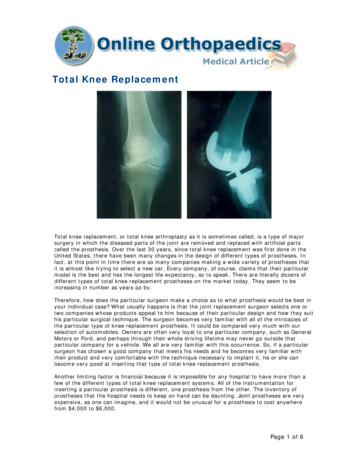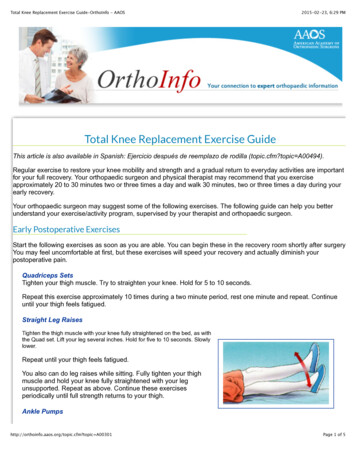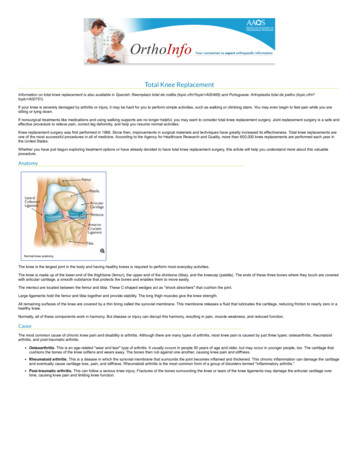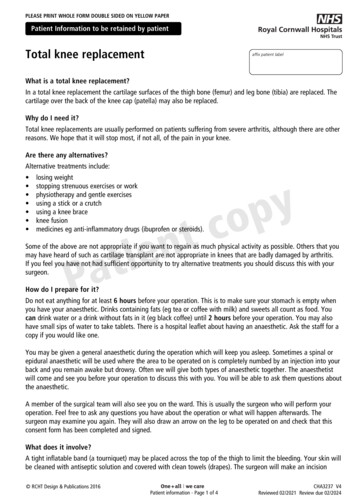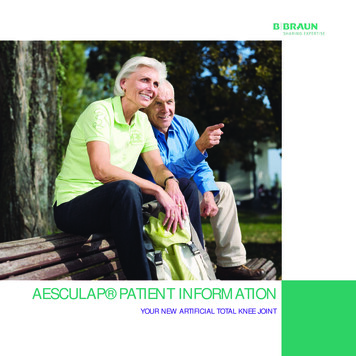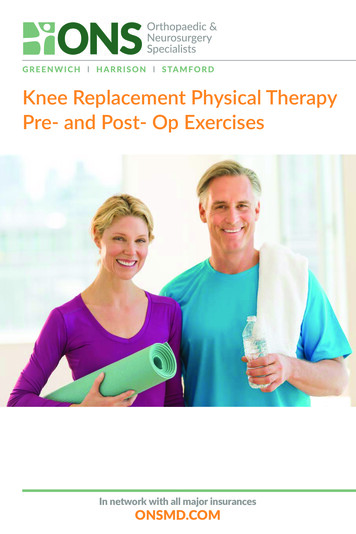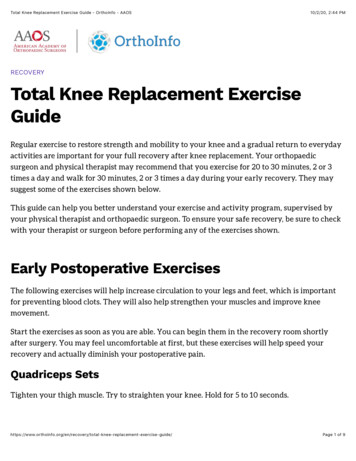
Transcription
Total Knee Replacement Exercise Guide - OrthoInfo - AAOS10/2/20, 2:44 PMRECOVERYTotal Knee Replacement ExerciseGuideRegular exercise to restore strength and mobility to your knee and a gradual return to everydayactivities are important for your full recovery after knee replacement. Your orthopaedicsurgeon and physical therapist may recommend that you exercise for 20 to 30 minutes, 2 or 3times a day and walk for 30 minutes, 2 or 3 times a day during your early recovery. They maysuggest some of the exercises shown below.This guide can help you better understand your exercise and activity program, supervised byyour physical therapist and orthopaedic surgeon. To ensure your safe recovery, be sure to checkwith your therapist or surgeon before performing any of the exercises shown.Early Postoperative ExercisesThe following exercises will help increase circulation to your legs and feet, which is importantfor preventing blood clots. They will also help strengthen your muscles and improve kneemovement.Start the exercises as soon as you are able. You can begin them in the recovery room shortlyafter surgery. You may feel uncomfortable at first, but these exercises will help speed yourrecovery and actually diminish your postoperative pain.Quadriceps SetsTighten your thigh muscle. Try to straighten your knee. Hold for 5 to 10 l-knee-replacement-exercise-guide/Page 1 of 9
Total Knee Replacement Exercise Guide - OrthoInfo - AAOS10/2/20, 2:44 PMRepeat this exercise approximately 10 times during a two-minute period, rest one minute, andthen repeat. Continue until your thigh feels fatigued.Quadriceps setStraight Leg RaisesTighten your thigh muscle with your knee fully straightened on the bed, as with the quadricepsset above. Lift your leg several inches. Hold for 5 to 10 seconds. Slowly lower.Repeat until your thigh feels fatigued.You also can do leg raises while sitting. Tighten your thigh muscle and hold your knee fullystraightened with your leg unsupported. Repeat as above.Continue these exercises periodically until full strength returns to your thigh.Straight leg raiseAnkle PumpsMove your foot up and down rhythmically by contracting your calf and shin muscles. Performthis exercise for 2 to 3 minutes, 2 or 3 times an hour in the recovery room.Continue this exercise until you are fully recovered and all ankle and lower-leg swelling total-knee-replacement-exercise-guide/Page 2 of 9
Total Knee Replacement Exercise Guide - OrthoInfo - AAOS10/2/20, 2:44 PMAnkle pumpKnee Straightening ExercisesPlace a small rolled towel just above your heel so that your heel is not touching the bed. Tightenyour thigh. Try to fully straighten your knee and to touch the back of your knee to the bed. Holdfully straightened for 5 to 10 seconds.Repeat until your thigh feels fatigued.Knee straightening exerciseBed-Supported Knee BendsSlide your foot toward your buttocks, bending your knee and keeping your heel on the bed. Holdyour knee in a maximally bent position for 5 to 10 seconds and then straighten.Repeat several times until your leg feels fatigued or until you can completely bend your knee.Bed-supported knee ee-replacement-exercise-guide/Page 3 of 9
Total Knee Replacement Exercise Guide - OrthoInfo - AAOS10/2/20, 2:44 PMSi!ing Supported Knee BendsWhile sitting at your bedside or in a chair with your thigh supported, place your foot behind theheel of your operated knee for support. Slowly bend your knee as far as you can. Hold your kneein this position for 5 to 10 seconds.Repeat several times until your leg feels fatigued or until you can completely bend your knee.Sitting supported knee bendSi!ing Unsupported Knee BendsWhile sitting at bedside or in a chair with your thigh supported, bend your knee as far as youcan until your foot rests on the floor. With your foot lightly resting on the floor, slide your upperbody forward in the chair to increase your knee bend. Hold for 5 to 10 seconds. Straighten yourknee fully.Repeat several times until your leg feels fatigued or until you can completely bend your knee.Sitting unsupported knee ee-replacement-exercise-guide/Page 4 of 9
Total Knee Replacement Exercise Guide - OrthoInfo - AAOS10/2/20, 2:44 PMEarly ActivitySoon after your surgery, you will begin to walk short distances in your hospital room andperform everyday activities. This early activity aids your recovery and helps your knee regainits strength and movement.WalkingProper walking is the best way to help your knee recover. At first, you will walk with a walkeror crutches. Your surgeon or therapist will tell you how much weight to put on your leg.Stand comfortably and erect with your weight evenly balanced on your walker or crutches.Advance your walker or crutches a short distance; then reach forward with your operated legwith your knee straightened so the heel of your foot touches the floor first. As you moveforward, your knee and ankle will bend and your entire foot will rest evenly on the floor. As youcomplete the step, your toe will lift off the floor and your knee and hip will bend so that you canreach forward for your next step. Remember, touch your heel first, then flatten your foot, thenlift your toes off the floor.Early on, walking will help you regain movement in your knee.Walk as rhythmically and smoothly as you can. Don't hurry. Adjust the length of your step andspeed as necessary to walk with an even pattern. As your muscle strength and enduranceimprove, you may spend more time walking. You will gradually put more weight on your leg.You may use a cane in the hand opposite your surgery and eventually walk without an ee-replacement-exercise-guide/Page 5 of 9
Total Knee Replacement Exercise Guide - OrthoInfo - AAOS10/2/20, 2:44 PMWhen you can walk and stand for more than 10 minutes and your knee is strong enough so thatyou are not carrying any weight on your walker or crutches (often about 2 to 3 weeks after yoursurgery), you can begin using a single crutch or cane. Hold the aid in the hand opposite the sideof your surgery. You should not limp or lean away from your operated knee.Stair Climbing and DescendingThe ability to go up and down stairs requires both strength and flexibility. At first, you will needa handrail for support and will be able to go only one step at a time. Always lead up the stairswith your good knee and down the stairs with your operated knee. Remember, "up with thegood" and "down with the bad." You may want to have someone help you until you haveregained most of your strength and mobility.Stair climbing is an excellent strengthening and endurance activity. Do not try to climb stepshigher than the standard height (7 inches) and always use a handrail for balance. As you becomestronger and more mobile, you can begin to climb stairs foot over foot.Stair climbing and descending using a crutchAdvanced Exercises and ActivitiesOnce you have regained independence for short distances and a few steps, you may increaseyour activity. The pain of your knee problems before surgery and the pain and swelling aftersurgery have weakened your knee. A full recovery will take many months. The followingexercises and activities will help you recover knee-replacement-exercise-guide/Page 6 of 9
Total Knee Replacement Exercise Guide - OrthoInfo - AAOS10/2/20, 2:44 PMStanding Knee BendsStanding erect with the aid of a walker or crutches, lift your thigh and bend your knee as muchas you can. Hold for 5 to 10 seconds. Then straighten your knee, touching the floor with yourheel first.Repeat several times until fatigued.Standing knee bendAssisted Knee BendsLying on your back, place a folded towel over your operated knee and drop the towel to yourfoot. Bend your knee and apply gentle pressure through the towel to increase the bend. Hold for5 to 10 seconds.Repeat several times until fatigued.Assisted knee bendKnee Exercises with tal-knee-replacement-exercise-guide/Page 7 of 9
Total Knee Replacement Exercise Guide - OrthoInfo - AAOS10/2/20, 2:44 PMYou can place light weights around your ankle and repeat any of the above exercises. Theseresistance exercises usually can begin 4 to 6 weeks after your surgery. Use one- to two-poundweights at first; gradually increase the weight as your strength returns. (Inexpensive wraparound ankle weights with Velcro straps can be purchased at most sporting goods stores.)ExercyclingExercycling is an excellent activity to help you regain muscle strength and knee mobility.At first, adjust the seat height so that the bottom of your foot just touches the pedal with yourknee almost straight. Peddle backwards at first. Ride forward only after a comfortable cyclingmotion is possible backwards.As you become stronger (at about 4 to 6 weeks) slowly increase the tension on the exercycle.Exercycle for 10 to 15 minutes twice a day, gradually build up to 20 to 30 minutes, 3 or 4 times aweek.Later on, excercycling will help you build strength in themuscles around your knee.Pain or Swelling a"er ExerciseYou may experience knee pain or swelling after exercise or activity. You can relieve this byelevating your leg and applying ice wrapped in a towel.Exercise and activity should consistently improve your strength and mobility. If you have anyquestions or problems, contact your orthopaedic surgeon or physical tal-knee-replacement-exercise-guide/Page 8 of 9
Total Knee Replacement Exercise Guide - OrthoInfo - AAOS10/2/20, 2:44 PMLast ReviewedFebruary 2017Contributed and/or Updated byJared R.H. Foran, MDPeer-Reviewed byStuart J. Fischer, MDAAOS does not endorse any treatments, procedures, products, or physicians referenced herein. Thisinformation is provided as an educational service and is not intended to serve as medical advice. Anyoneseeking specific orthopaedic advice or assistance should consult his or her orthopaedic surgeon, or locateone in your area through the AAOS Find an Orthopaedist program on this l-knee-replacement-exercise-guide/Page 9 of 9
Total Knee Replacement Exercise Guide - OrthoInfo - AAOS 10/2/20, 2:44 PM eplacement-exercise-guide/ Page 4 of 9
